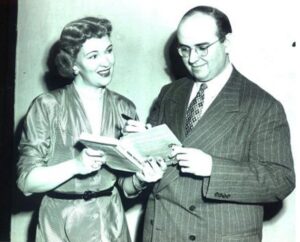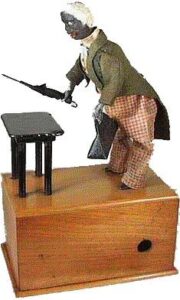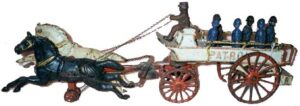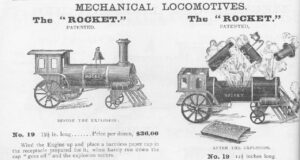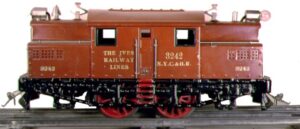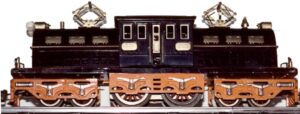Real Santa Clauses
By Louis H. Hertz
Mr. Ives
Many years ago, in a quiet New England town, a young man began to make toys. The year was 1868, the town was Plymouth, Connecticut, and the persevering young man’s name was Edward R. Ives. This was just after the Civil War, when many enterprising men with mechanical talents were seeking new things to make. Not many of them thought of toys; they did not think toys were important enough to be worth making carefully and well. Edward Ives did not feel this way. He wanted to make toys for the boys and girls of America, for the boys and girls of the whole world, in fact, and to make them just as fine as he could.
“Real Santa Clauses” that it would appear were written for a younger or youth reader. Probably some “Boys Magazine” of the day, what day I can’t tell you as the articles were not dated. I’ve copied the article word for word including what my word processor claims are misspellings and in some cases poorly constructed sentences. Lou never used a computer or a word processor and I’m sure he would have been quite put out to find that Mr. Gates’ software doesn’t like some of his punctuation. That was another time, but the following article is still true today as it was the day he wrote it.
Dave McEntarfer
Many people thought this was foolish. They did not think toys were worth this care, and they could not see any possibilities in the future of a business where toys were made with such care. But Edward Ives went ahead, and this was the start of the famous Ives toy manufacturing business that was to make toys for over sixty years. The business which was started in 1868 was to become famous all over the world.
It is hard to think of Edward Ives as a young man. He made so many toys for so many, many years that people who had played with his toys when they were children and then saw their children and grandchildren playing with Ives toys came to think of him as a sort of permanent real-life Santa Claus, as if he had never himself been young and played with toys. Perhaps it was some of the crude toys that he had played with as a boy that inspired him to want to make much better toys when he grew up.
Probably Edward Ives was the closest thing to a real Santa Claus that our toymaking industry produced. He was, like Santa Claus, a friendly, jolly sort of man, and like Santa Claus, he loved children. But unlike Santa Claus, he was a small, short, thin man and instead of Santa’s long white beard he had only a mustache. When it came to toy making though, he was the nearest thing to Santa Claus we ever had. When he became an old man, and his hair and mustache had turned white, many people wondered how such a seemingly little man could have invented and made so many, many toys.
When Edward Ives was twenty-seven years old, in 1866, he married a girl in Plymouth named Jennie Blakeslee. Two years later, he and Jennie’s father, Joel Blakeslee, and her brother, Cornelius, started to make toys in Plymouth. The first toys they made were little movable figures of men and animals called hot air toys. They were worked by little weather vanes which were turned by the rising hot air from old-fashioned stoves. The toys had to be very light, so the air would be strong enough to make them move, and were made mostly of paper. The hot air toys were of different kinds. One showed a man sawing wood, and another a cat playing a fiddle. Still another was of a man tipping his hat and bowing to a lady.
Soon Edward Ives wanted to make other kinds of toys, and to make more of each kind than was possible in the small town of Plymouth. His toys had already become very popular. In 1870 he moved his growing business to the city of Bridgeport, Connecticut. His wife, his little boy, Harry, and Joel Blakeslee and his wife also moved to Bridgeport. Cornelius Blakeslee moved down to New York to spend all his time selling the many toys which Edward Ives would make in Bridgeport.
In Bridgeport, Edward Ives began making fine clockwork toys of all kinds. One wonderful type of toy followed another, and as the demand grew constantly, most of them were made by the thousands and thousands. More and more factory space had to be acquired in Bridgeport for the toymaking of Ives, Blakeslee & Co., as the business was then known.
What wonderful days and what wonderful toys those were! There were clockwork rowboats with little men who would paddle them across water with tiny oars, carts and wagons drawn by galloping horses, boys and girls on swings and see-saws; men and women dancing, churning butter, playing fiddles, or riding bicycles. There were mechanical rocking horses and circus horse trainers and big steamboats which ran across the floor when you would wind them up. There were dolls and figures of famous men that would walk, and even the most wonderful of all dolls, which would not only walk, but actually say “Mama” and “Papa” as well!
But most interesting to the boys, then as now, were the locomotives and trains. The first of the Ives locomotives, the first of millions which Edward Ives and his son Harry were to make, were of tin. They were powered by clockwork and ran across the floor without track. Some came with trains of cars. There were many sizes, and all of them were brightly colored. Most of them were larger than the toy locomotives of today.
In those days every real railroad locomotive had its own name, and each of the Ives tin toy locomotives was named, too. Some of the names of the locomotives Edward Ives made in the 1870’s, 1880’s, and 1890’s were Vulcan, Victory, Lion, Tiger, Giant, Whistler, and Grand Duke. They seemed very much like the real locomotives to the boys who played with them. You could run them in a straight line or a circle by adjusting the front wheels.
It may perhaps come as a surprise to you to learn that even back in those days it was possible for boys to have toy locomotives that really whistled or smoked, but some of Mr. Ives’ locomotives would do these things. Away back in 1874 he invented a toy locomotive that would whistle as it ran along, and later he made one that would really smoke! This was done by means of an arrangement whereby a lighted cigarette could be concealed inside the smokestack, and the smoke would be puffed out by means of a special connection with the clockwork motor.
In the 1880’s Ives started making many toys of cast iron. As time went on, they made more and more out of this material. Some were clockwork powered, but others were designed to be pulled or pushed along. There were iron horse-drawn fire engines of all kinds – drays, express wagons, Hansom cabs, ice wagons, coal trucks, locomotives and trains, and many others.
Ives made so many different types of toys at this time that it is just impossible to tell about all of them. In fact, it seems they made almost every type of toy that was produced at this time. Many of them they made first, before anyone else, and many of their toys were copied by other toymakers. Among the toys which Ives made in the 1880’s and 1890’s, besides the clockwork and iron toys of the kind already described, were working steam engines and boats, cap pistols, cannon, games, sewing machines, balls, and banks. But first the clockwork toys, then the iron toys, and always the locomotives and cars were the most important toys of all.
When Edward Ives’ son, Harry, grew up, he too went to work in the toy business. In many ways he was like his father, and he also invented many new and wonderful kinds of toys. There was one very important thing that both Edward and Harry Ives always insisted on. They would not make cheap, shoddy toys. Every toy they made had to be constructed of the finest materials and with the best workmanship possible. They would not make anything which was not the very best in every way. They would rather stop making a toy than have to make it in cheap, poor form. Often, if one of their toys was copied in a poor duplicate by somebody else they would simply stop making the toy themselves.
Because of this, by the late 1890’s, Ives was making mostly iron toys. Many of their fine clockwork toys had been cheaply copied in Germany, and they were not making them any longer. To look at an old Ives catalog is to take a wonderful trip into toyland and marvel at all the wonderful toys this famous old company turned out. Those who have studied the subject carefully say they are justly called America’s greatest toymakers. Recently a great newspaper, in remembering the famous old Ives toys, said that “Mr. Ives” was “better known than Santa Claus himself.”
One of the most interesting toys made by Ives in the 1890’s was a toy fire house. It was made of wood, with cast iron doors and windows, and looked just like the old-time fire houses seen in Bridgeport and other cities. It contained a clockwork mechanism and bell. When the clockwork was wound up and started, nothing would happen for a little while. Then the alarm bell would ring the call to the imaginary firemen – once, then twice, and then four times – a 1-2-4 alarm! Then the iron doors suddenly would fly open and the little Ives iron toy fire engine would rush out as it came down a little incline!
Just before Christmas in 1900 there came a sad day for Edward and Harry Ives when the real fire engines in Bridgeport were called out of their engine houses to answer an alarm. The Ives factory was on fire! No one knew how the fire started, but it was a big fire, and soon all the fire engines in Bridgeport rushed to help put it out, their strong horses galloping down the streets to bring the steam fire engines to the fire as soon as possible. Before the brave firemen had the fire under control the Ives factory was destroyed. Tens of thousands of boys were made happy that Christmas by the Ives toys they received, but it was a very sad Christmas indeed for Edward and Harry Ives.
Some people thought that it would mean the end of Ives toys when they heard of the fire, but not the Iveses. They started looking around right away for factory space where they could start making toys again, and soon found some room in another building. It was there that they started making their most famous toys of all, the Ives miniature trains. These new toy trains, which they began making in 1901, ran on tracks, and had all the equipment of the real ones. There were all sorts of freight and passenger cars, and stations, switches, signals, bridges, and tunnels. The first trains of the new Ives Miniature Railway System were clockwork powered. In 1910 they started making electric trains as well.
Each train made by the Ives Manufacturing Company was considered to form a division of the Ives Railway Lines, and the boy who owned it was a Division Superintendent. Each year new and improved model locomotives, cars, and accessories were added for the building of a complete miniature railroad system. Many of them were invented or designed by Harry Ives, who took especial interest in the trains. But Edward Ives, although now an old man, kept coming to the factory every day to still help make the trains and toys. He loved to sit and test some of the little locomotive motors that would go out to his young friends to haul trains on their divisions of the Ives Railway Lines. He would always work on the clockwork trains, which he liked better than the electrics.
Then one day not too long before Christmas, 1918, old Mr. Ives did not come to the factory. He had made Ives toys for just fifty years, but now the man who had made so many children happy had been called away from the scene of the work he loved so much. And when some little boys heard that Mr. Ives had died, they cried, for they knew they had lost a real friend.
His son, Harry C. Ives, carried on the business alone for a time, and it kept growing all the time. It was in the 1920’s that some of the finest Ives trains were made. Harry Ives was now the Mr. Ives, and many are the stories told of his kindness and generosity, and his continued insistence that every toy that bore the famous name “Ives” be just as fine as it was possible to make it.
As a result, in some ways the 1920’s were a golden age of toy trains. Many of the most popular features of modern toy electric trains, such as remote control reverse, were perfected by Ives designers at that time. Just as important as the trains themselves, was the friendly way the Ives Company looked upon the young owners of their products and always made them all seem a part of one big happy family. Thousands and thousands of boys who were Ives Railway Lines operators have never forgotten the great days when Edward and Harry Ives made toys.

